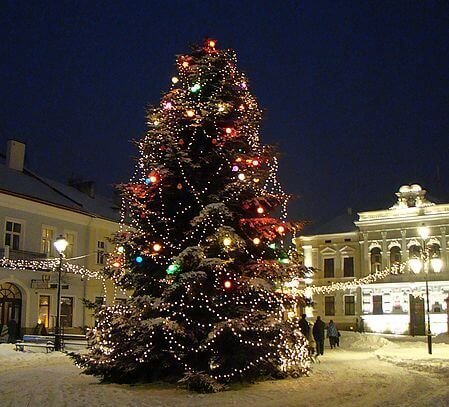How Fir Trees Became Christmas Trees
by Pat Tucker
Broadcast 12.23.2018

Listen:
Fir trees, decorated and lighted, are such a fixture of American homes at Christmas that it’s difficult for us to imagine that it was not always so. But on a time scale of 1 to 10, with 1 being the beginning of life on earth, the Christmas tree tradition begins somewhere around 9.999999999.
The earliest story that mentions fir trees as a plant associated with the infant Jesus dates to early 700 AD. At that time Christians were attempting to convert the Druids to the Christian faith. One of the ways they undertook this was to denounce and ban sacred Druid symbols, one of which was the oak tree. As the story goes, St. Boniface, a British monk and missionary, was preaching about the nativity to a tribe of Germanic Druids. To convince them that the oak tree was not holy and inviolable, he chopped one down on the spot. It fell with a thunderous crash, crushing everything in its path – except for a small fir sapling which reached up straight and true through the branches of the fallen giant. Always on the alert to take advantage of a chance event, Boniface quickly proclaimed the fir’s survival as a miracle and proclaimed the fir to be the tree of the Christ child.
By the 16th century the decorated fir tree, indoors and out, was a firmly established tradition in Germany. Martin Luther is credited with adding lights to trees. It is said that walking home one star-lit winter night, he was so struck with the beauty of the stars twinkling through the branches of the fir trees that he recreated the scene by wiring candles to his Christmas tree.
The tradition of Christmas trees was established in America only 200 years ago as a result of the influx of German and Irish immigrants who undermined the strict influence of the Puritans. The Puritans believed that any observance of December 25, other than a church service, was sacrilegious and had gone so far as to pass laws making Christmas decoration illegal and punishable by a fine. In this age of lavish Christmas decoration and ornately decorated trees, it’s difficult for us to conceive of Christmas without them, but it’s wise for us to remember that customs and mores change over time to meet the needs and desires of society.
Like the displaced oak tree, the decorated fir may, for generations in the future, lose its position as the centerpiece of holiday decorating. However, just as the fir tree appeared victorious from within the branches of the dethroned oak, it is safe to say that another custom, just as cherished, will emerge to take its place. It’s human nature and, for myself at least, part of what makes us such an interesting part of life on earth.
Every week since 1991, Field Notes has inquired about Montana’s natural history. Field Notes are written by naturalists, students, and listeners about the puzzle-tree bark, eagle talons, woolly aphids, and giant puffballs of Western, Central and Southwestern Montana and aired weekly on Montana Public Radio.
Click here to read and listen to more Field Notes. Field Notes is available as a podcast! Subscribe on iTunes, Google Play, or wherever you listen to podcasts.
Interested in writing a Field Note? Contact Allison De Jong, Field Notes editor, at adejong [at] montananaturalist [dot] org or 406.327.0405.
Want to learn more about our programs as well as fun natural history facts and seasonal phenology? Sign up for our e-newsletter! You can also become a member and get discounts on our programs as well as free reciprocal admission to 300+ science centers in North America!












